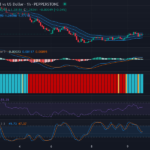US Tariffs on EU Exports: A Looming Threat to Eurozone Growth
Tháng 4 9, 2025
GBP/USD Forex Market Undergoing Neutral Momentum: A Comprehensive Technical Analysis – 09/04/2025
Tháng 4 9, 2025The Federal Reserve’s Rate Cuts: Impacts of Stock Market Performance and Economic Uncertainty
Recent discussions surrounding potential rate cuts by the Federal Reserve have become increasingly relevant as economic factors converge to shape market expectations. The actions and projections of the Fed are being influenced by a combination of stock market volatility, tariff impacts, and broader economic growth forecasts. Understanding this intricate interplay will help gauge the likelihood of future monetary policy changes.
Stock Market Performance and Rate Cut Expectations
The stock market has recently experienced notable fluctuations, resulting in heightened expectations of impending rate cuts by the Federal Reserve. As stock valuations see a decline, investors typically pivot towards anticipating more accommodating monetary policies designed to bolster economic activity. Historically, when market conditions become unstable, the Fed has often responded by adjusting interest rates to support growth. This responsiveness reflects an important aspect of their dual mandate: to promote maximum employment while maintaining stable prices. Therefore, if the stock market continues its volatility, the probability of the Fed considering rate cuts increases significantly. For insights into how value investing strategies can capitalize on these market fluctuations, you can read more about it here.
Tariffs and Economic Uncertainty
Another layer of complexity in the current economic landscape is the introduction of new tariffs, which have injected a significant amount of uncertainty within various sectors. These tariffs are expected to exacerbate existing inflation concerns while simultaneously dampening economic growth prospects. As the burden of tariffs impacts businesses and consumers alike, the Federal Reserve may find itself in a position where swift interest rate cuts become a necessary response to mitigate the potential economic fallout. Moreover, economic analyses suggest that continued tariff implementations could hinder the Fed’s ability to control inflation without sacrificing growth. This aspect is especially critical as China’s trade policies play a pivotal role, reflecting how tariffs can introduce further economic uncertainty. For a deeper understanding of these dynamics, check out this article on the strategic moves by China in the current trade landscape here.
Fed’s Cautious Approach
Despite rising inflation concerns that might typically prompt a more aggressive response, Federal Reserve Chairman Jerome Powell has indicated a cautious approach regarding policy changes. He has made it clear that the Fed intends to evaluate the economic landscape thoroughly before making any decisions. Should the economy exhibit signs of significant weakening, the Fed might prioritize monetary policy that favors growth over controlling inflation. However, this balancing act is fraught with challenges, as persistent inflationary pressures could complicate the decision-making process.
Economic Growth Projections
Compounding these challenges are revised forecasts for U.S. GDP growth, which have been adjusted downwards due to the negative consequences associated with tariffs and ongoing policy uncertainties. Current estimates project a growth rate as low as 1.2% for 2025. This sluggish growth outlook poses additional complications for the Federal Reserve as they navigate the delicate terrain of rate cuts while attempting to manage inflation expectations. The juxtaposition of increasing inflation projections against declining growth estimates complicates an already intricate decision-making process. Understanding the investment mistakes to avoid during such volatile times is crucial; for guidance on this, refer to insights on key investment pitfalls here.
In conclusion, the relationship between stock market performance, tariff implications, and the overall economic outlook is paramount in shaping expectations around Federal Reserve rate cuts. The evolving events in these areas will continue to influence how and when the Fed might implement changes to interest rates, making it crucial for investors and economists alike to remain vigilant in monitoring these dynamics heading into 2025.
